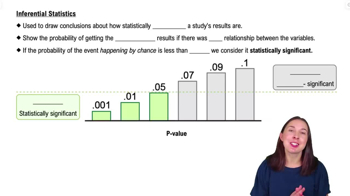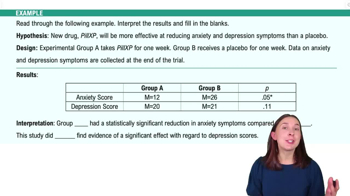Table of contents
- 1. Introduction to Psychology1h 43m
- 2. Psychology Research2h 20m
- 3. Biological Psychology2h 41m
- 4. Sensation and Perception28m
- 5. Consciousness and Sleep32m
- 6. Learning41m
- 7. Memory34m
- 8. Cognition37m
- 9. Emotion and Motivation35m
- 10. Developmental Psychology33m
- 11. Personality48m
- 12. Social Psychology41m
- 13. Stress and Health41m
- 14. Psychological Disorders44m
- 15. Treatment47m
2. Psychology Research
Evaluating Research Findings
Struggling with Psychology?
Join thousands of students who trust us to help them ace their exams!Watch the first videoMultiple Choice
Desmond is a graduate student who does a lot of work with household income data, and his samples almost always have outliers. Which measure of central tendency might be the most useful for Desmond to use?
A
Mean.
B
Median.
C
Mode.
D
Range.
 Verified step by step guidance
Verified step by step guidance1
Understand the problem: Desmond is dealing with household income data that often includes outliers. Outliers are extreme values that can skew the data.
Review the measures of central tendency: Mean, median, and mode are common measures. The mean is the average, the median is the middle value when data is ordered, and the mode is the most frequently occurring value.
Consider the impact of outliers: Outliers can significantly affect the mean, making it less representative of the data set as a whole.
Evaluate the median: The median is less affected by outliers because it is simply the middle value, making it a more robust measure of central tendency in the presence of outliers.
Conclude that the median is the most useful measure for Desmond's data, as it provides a better central tendency representation when outliers are present.

 6:00m
6:00mWatch next
Master Descriptive Statistics – Measures of Central Tendency with a bite sized video explanation from Hannah Gordils
Start learningRelated Videos
Related Practice















![Ethical Guidelines in Psychology [AP Psychology Unit 1 Topic 6] (1.6)](https://img.youtube.com/vi/ilq2nGO7_QA/mqdefault.jpg)





























